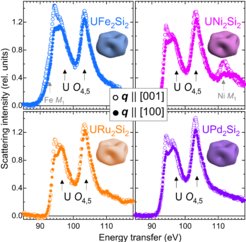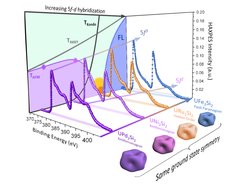Duality of 5f electrons in UM2Si2
In many fascinating U intermetallic compounds, the intricate interplay of band formation and electron correlation effects of the U 5f electrons is an intellectual challenge that has not yet been mastered. The question is, should the modelling start with band theory or a local atomic approach? This has been particularly troublesome because neither the presence nor the symmetry of the active atomic-like states was so far experimentally accessible nor are there generally accepted numbers for the filling of the 5f shell.
A team of scientists from MPI CPfS in Dresden, University of Cologne, University of Erlangen, Heidelberg University, University of California at San Diego, Los Alamos National Laboratory, Institute of Low Temperature & Structure Research in Wroclaw, Van-der-Waals-Zeeman Institute in Amsterdam, and the German Synchrotron in Hamburg (PETRA-III/DESY) has carried out a comparative investigation of the electronic structure of isostructural members of the UM2Si2 family with very different ground state properties. The UM2Si2 compounds with M=Pd and Ni are antiferromagnets with large magnetic moments, that with M=Ru is the so-called hidden order compound, and that with M=Fe is a Pauli paramagnet.

Non-resonant inelastic x-ray scattering experiments beyond the dipole limit (an innovative and very unique spectroscopic method) reveal the presence of atomic-like multiplet states in all four compounds and that the compounds have the same singlet ground-state symmetry of the U 5f2 configuration in common. It is shown that a quasi-doublet consisting of the two singlets states G2 and G1 of majority Jz=|+4> + |-4>) can induce large-moment magnetism (M=Pd and Ni) as well as the hidden order. Bulk-sensitive hard x-ray photoemission shows a systematic increase of f-d hybridization and itineracy from M= Pd to Ni to Ru to Fe. Hence, local-moment systems (M=Ni, Pd) highlight the local atomic aspects of the electronic structure while Pauli paramagnets (M=Fe) rather reflect the importance of band formation but with bands that are strongly renormalized due to the remnant local aspect. URu2Si2, with its hidden order and superconductivity, is in-between these two regimes.
The above findings demonstrate the validity of the concept the dual nature of U 5f electrons for this set of U compounds. The experiments also explain why in URu2Si2 the hidden order disappears with pressure and why a large magnetic moment emerges.
AA, MS, AL-J, AS, LHT /CPfS













